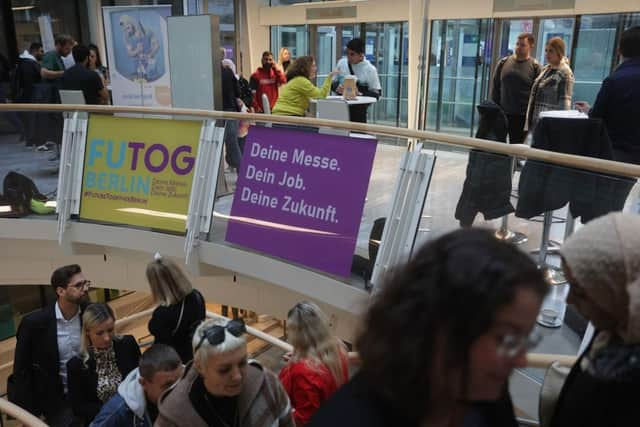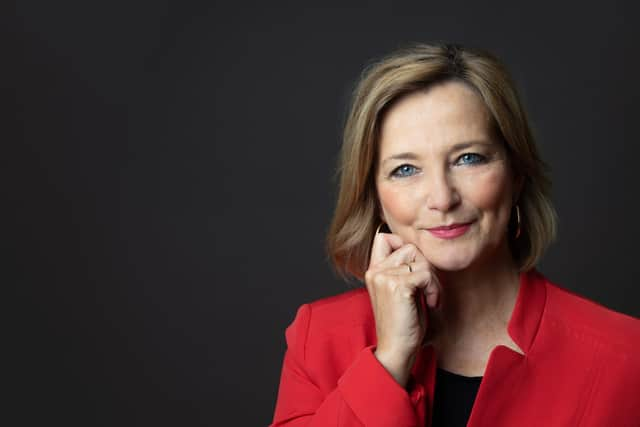Migrants Europe: How can Germany cope with the largest refugee population in Europe?
As hundreds of thousands of refugees poured into Germany from the Middle East in the middle of the past decade, then-Chancellor Angela Merkel brushed off concerns.
"Wir schaffen das”, she famously told a press conference, following a visit to a refugee camp in Dresden in 2015. “We will manage it.”
Advertisement
Hide AdAdvertisement
Hide AdEight years later and Germany, once a beacon of liberal refugee policy, is facing internal political turmoil over the issue as it struggles to cope with the number of asylum seekers within its borders.


German president Frank-Walter Steinmeier, of the centre-left Social Democratic Party of Germany, warned the number of migrants coming to the country had pushed it to “breaking point”, as he called for a more fair European system of migrant distribution.
“Germany, like Italy, is at the limit of its capacity,” Mr Steinmeier said in an interview with Italian newspaper Corriere della Sera last month.
Since 2012, Germany has received the most asylum applications in absolute numbers of any country in the European Union – and the figure is continuing to rise. There were around 217,770 first-time asylum applications in 2022 – around a quarter of the total received within the EU – while in the first eight months of this year, the Federal Office for Migration and Refugees already received 204,460 such applications.
This is still likely to be far lower than the peak year of 2016, when German authorities received 772,370 applications for asylum, many of them from people fleeing the war in Syria and persecution in countries like Afghanistan.


The most recent figures, however, do not include over one million Ukrainian refugees who have arrived in the country since the Russian invasion began 18 months ago. They are not counted in these figures, due to the fact they do not have to claim asylum in the same way as arrivals from elsewhere, but are granted an automatic temporary residents’ permit.
The number of Ukrainians in Germany is a stark contrast to the equivalent figure in the UK, which has taken in just 180,000 refugees from the war-torn nation since February last year.
Petra Bendel, professor of political science and head of research unit for migration, displacement and integration at Friedrich-Alexander University Erlangen-Nürnberg, says Chancellor Olaf Scholz, who took over the role in December 2021, is coming under pressure from all sides of the political spectrum to tackle immigration.
Advertisement
Hide AdAdvertisement
Hide Ad“The question of immigration and displacement ranks high among the most pressing problems in Germany,” she tells The Scotsman. “It is therefore of utmost importance for the German Government to show that it takes control.”
A recent report published by employment agency EWL and the Center for East European Studies at the University of Warsaw found an increasing number of Ukrainian refugees who had settled in Poland after the outbreak of war were now moving to Germany where they perceived there were better employment opportunities.
“When politicians talk these days about ‘stress limits’, we have to take into account that this number of asylum seekers comes on top of the high number of refugees from the Russian war of aggression in Ukraine, which amounts to over one million,” Prof Bendel says.
Studies have shown a significant proportion of Ukrainian refugees in Germany intend to stay there for the medium to long term. Under a scheme launched after the invasion, Ukrainian refugees have the right to live there until March next year.
"This means that the municipalities still have to take care of their integration,” Prof Bendel adds.
She says basic standards of living have become a challenge in Germany, not only for refugees, but for many among the general population as resources are squeezed amid a cost-of-living crisis, soaring energy bills and the war in Ukraine.
“Since it must be assumed that many protection seekers will not be able to return to their countries of origin for a longer period of time due to war and destruction, cities and municipalities will be challenged for years,” she says. “It is therefore not only a matter of providing adequate initial care, but also of longer-term integration – access to housing and health services, to language courses, day-care and school facilities as well as to the labour market.
"And here lies the crux: one’s own four walls, reliable childcare, quality schooling or simply an early appointment for counselling at the job centre – these services have become rare in Germany anyway. There has long been a shortage of skilled personnel, including teachers, educators and administrative staff.”
Advertisement
Hide AdAdvertisement
Hide AdThe German federal system means there is division between the central government and the municipalities who end up with responsibility for asylum seekers on a day-to-day basis.
Two weeks ago, the German government said it would strengthen controls along its border with Poland and the Czech Republic in a bid to curb the numbers of asylum seekers entering the country illegally.
The move, which will see “flexible priority checks” on routes known to be used by people traffickers, comes amid growing support for the far-right Alternative for Germany party, known as the AfD, not only in the east, but also in some western states.
“We must stop the cruel business of smugglers who put human lives at risk for maximum profit,” said interior minister Nancy Faeser, announcing the new measures.
As part of his re-election campaign in Bavaria, conservative governor Markus Söder has suggested capping migration at 200,000 asylum seekers a year.
“There are, again and again, refugee summits between the federal government, the states and the municipalities,” says Prof Bendel. “The next Minister Presidents’ Conference in early November will also have to negotiate with Chancellor Olaf Scholz on more permanent and reliable funding mechanisms for the municipalities.
"It is, indeed, key to support cities and municipalities who work on the ground: Local integration work creates social cohesion and thereby also supports the development of a crisis-resistant diverse population.”
Comments
Want to join the conversation? Please or to comment on this article.
